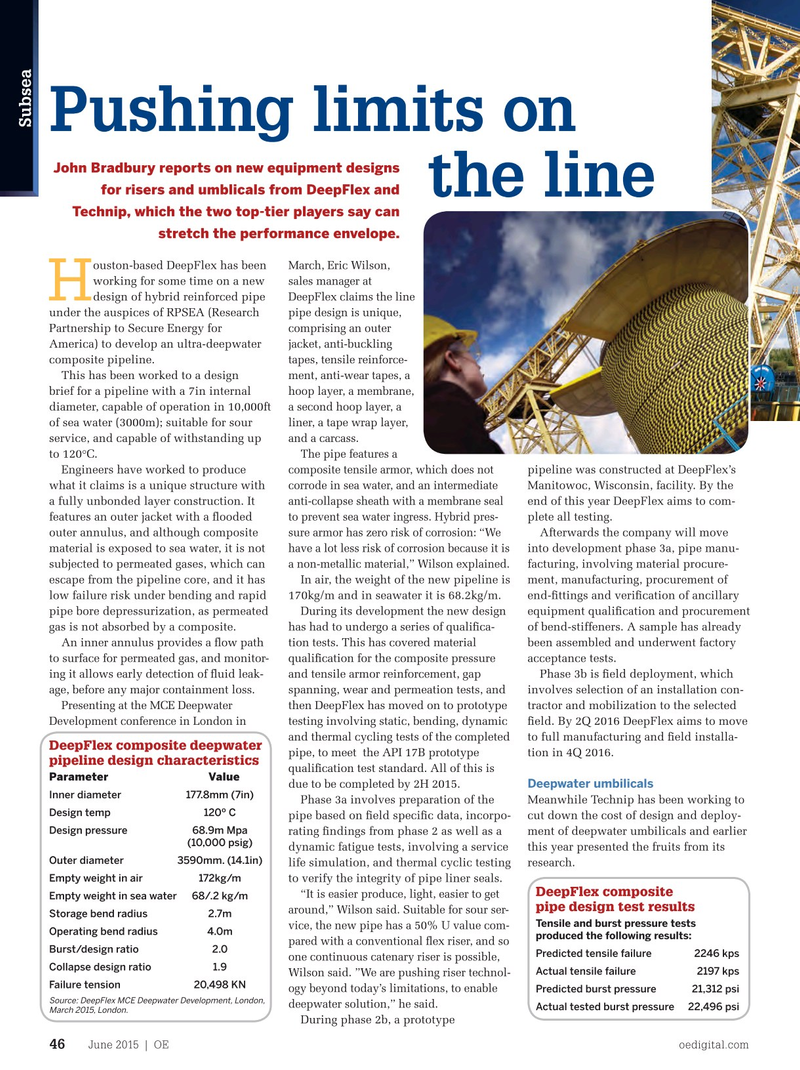
Page 44: of Offshore Engineer Magazine (Jun/Jul 2015)
Read this page in Pdf, Flash or Html5 edition of Jun/Jul 2015 Offshore Engineer Magazine
Subsea
Pushing limits on
John Bradbury reports on new equipment designs for risers and umblicals from DeepFlex and the line
Technip, which the two top-tier players say can stretch the performance envelope.
ouston-based DeepFlex has been
March, Eric Wilson, working for some time on a new sales manager at
H design of hybrid reinforced pipe
DeepFlex claims the line under the auspices of RPSEA (Research pipe design is unique,
Partnership to Secure Energy for comprising an outer
America) to develop an ultra-deepwater jacket, anti-buckling composite pipeline.
tapes, tensile reinforce- ment, anti-wear tapes, a
This has been worked to a design hoop layer, a membrane, brief for a pipeline with a 7in internal a second hoop layer, a diameter, capable of operation in 10,000ft liner, a tape wrap layer, of sea water (3000m); suitable for sour and a carcass.
service, and capable of withstanding up
The pipe features a to 120°C. Defning the characteristics of a pipeline was constructed at DeepFlex’s Engineers have worked to produce subsea umbilical, Ian Probyn, research composite tensile armor, which does not
Manitowoc, Wisconsin, facility. By the what it claims is a unique structure with and development business manager for corrode in sea water, and an intermediate end of this year DeepFlex aims to com- a fully unbonded layer construction. It Technip, outlined the units as the critical anti-collapse sheath with a membrane seal plete all testing. features an outer jacket with a fooded connection to control subsea oil and gas to prevent sea water ingress. Hybrid pres-
Afterwards the company will move outer annulus, and although composite equipment. Typically they comprise a sure armor has zero risk of corrosion: “We into development phase 3a, pipe manu- material is exposed to sea water, it is not protective outer sheath, polymer fller have a lot less risk of corrosion because it is a non-metallic material,” Wilson explained.
facturing, involving material procure- subjected to permeated gases, which can elements, fber optic and electrical cables ment, manufacturing, procurement of In air, the weight of the new pipeline is escape from the pipeline core, and it has and fuid conduits within thermoplastic end-fttings and verifcation of ancillary 170kg/m and in seawater it is 68.2kg/m. low failure risk under bending and rapid hoses, or steel tubes.
equipment qualifcation and procurement During its development the new design pipe bore depressurization, as permeated Deepwater umbilicals have to perform of bend-stiffeners. A sample has already has had to undergo a series of qualifca- gas is not absorbed by a composite. against a number of key factors including been assembled and underwent factory tion tests. This has covered material An inner annulus provides a fow path the basic design, component mix, capacity acceptance tests. qualifcation for the composite pressure to surface for permeated gas, and monitor- requirements and manufacturing assets.
Phase 3b is feld deployment, which and tensile armor reinforcement, gap ing it allows early detection of fuid leak- And during their installation, Probyn involves selection of an installation con- spanning, wear and permeation tests, and age, before any major containment loss. explained how umbilicals have to con-
Presenting at the MCE Deepwater tractor and mobilization to the selected then DeepFlex has moved on to prototype tend with hold-back tensioners, manage
Development conference in London in feld. By 2Q 2016 DeepFlex aims to move testing involving static, bending, dynamic the effects of inertia or DAF (dynamic to full manufacturing and feld installa- and thermal cycling tests of the completed amplifcation factor), as well as instal-
DeepFlex composite deepwater tion in 4Q 2016. pipe, to meet the API 17B prototype lation unit track length, and type, in pipeline design characteristics qualifcation test standard. All of this is addition to crush loads, heavier inner
Parameter Value
Deepwater umbilicals due to be completed by 2H 2015. bundles, and offshore hold times. And
Inner diameter 177.8mm (7in)
Meanwhile Technip has been working to Phase 3a involves preparation of the they have to deal with in-service condi-
Design temp 120º C cut down the cost of design and deploy- pipe based on feld specifc data, incorpo- tions of usage, fatigue, buoyancy, and the
Design pressure 68.9m Mpa ment of deepwater umbilicals and earlier rating fndings from phase 2 as well as a type of vessel to which they are attached.
(10,000 psig) this year presented the fruits from its dynamic fatigue tests, involving a service In deepwater, the “install-ability” of
Outer diameter 3590mm. (14.1in) research. life simulation, and thermal cyclic testing an umbilical depends on the nature of
Empty weight in air 172kg/m to verify the integrity of pipe liner seals. the friction equipment – usually cater-
DeepFlex composite “It is easier produce, light, easier to get pillar tracks or grabbers on deployment
Empty weight in sea water 68/.2 kg/m pipe design test results around,” Wilson said. Suitable for sour ser- vessels – and the top tension imposed on
Storage bend radius 2.7m
Tensile and burst pressure tests vice, the new pipe has a 50% U value com- the umbilical, as well as its size, length,
Operating bend radius 4.0m produced the following results: pared with a conventional fex riser, and so and its crush capacity. Installation is
Burst/design ratio 2.0
Predicted tensile failure 2246 kps one continuous catenary riser is possible, described by Probyn as the most critical
Collapse design ratio 1.9
Actual tensile failure 2197 kps
Wilson said. ”We are pushing riser technol- phase in the service life of an umbilical.
Failure tension 20,498 KN ogy beyond today’s limitations, to enable
In deeper water, there is greater top
Predicted burst pressure 21,312 psi
Source: DeepFlex MCE Deepwater Development, London, deepwater solution,” he said.
tension, greater weight, more compo-
Actual tested burst pressure 22,496 psi
March 2015, London.
During phase 2b, a prototype nents, necessitating larger installation
June 2015 | OE oedigital.com 46 046_OE0615_Subsea1_John.indd 46 6/1/15 12:13 PM

 43
43

 45
45